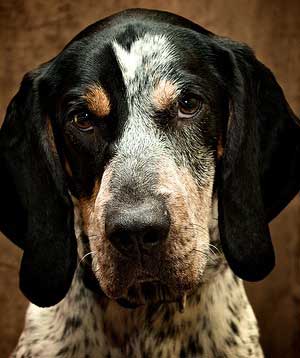Category Details
Description:
Country of Origin: The American English Coonhound, also known as the English Coonhound and the Redtick Coonhound, has its origins from England where it evolved from the descendants of the English Foxhound that was brought over from Europe. It is said that all hound breeds, with the exception of the Plott Hound, are descendant from the English Foxhound. The American English Coonhound was developed from the “Virginia Hounds” when men such as the first president of the United States, George Washington, set out to create a hound that was better suited to the rougher terrain. The breed was used for all variations of hunting, including treeing, and were regularly utilized to hunt raccoon and American Red Fox. The Treeing Walker Coonhound and the Bluetick Coonhound were lumped into the breed originally, but received separate recognition in the 1940"s. The American English Coonhound became recognized by the UKC in 1905, but was not fully recognized by the AKC until 2011.
Size: The American English Coonhound male can reach heights of 22-27 inches tall, while the female is only slightly smaller reaching heights of 21-25 inches. The weight of the American English Coonhound should be proportionate to their height, but will typically range from 40-65 pounds.
Coat: The American English Coonhound"s coat is short and hard and this breed is an average shedder. Their coat can come in a variation of colors. This can include blue and white ticked, red and white ticked, tri-colored with ticking, red and white and white and black. Red or black coloring in excess is considered a fault in regards to showing.
Character: The American English Coonhound is pleasant and sociable. It has strong hunting instincts, great speed and an excellent voice. They possess strong prey drive and they also have a strong instinct for treeing animals. It is due to this that this breed is not recommended for homes with small animals. They will think of them as prey to be treed! The American English Coonhound will do better around older children, but can become accustomed to small children as well. This breed needs to be well socialized at a young age to avoid possible dog aggression or wariness of strangers. The American English Coonhound can also make a very good guardian due to its loud bark and devotion to its “pack”.
Temperament: The American English Coonhound is an energetic and intelligent dog with exceptional hunting abilities. They can be a stubborn breed, requiring a good amount of patience from its owner. They require a firm, authoritative and consistent pack master. They are, by nature, devoted to their family as well as being very sociable and therefore make great companion dogs. The American English Coonhound is a nester by nature, and will most likely take up residence on your couch or bed while inside the home. If you prefer not sharing your bed or couch with your dog, this breed may not be for you.
Care: The American English Coonhound is easy to groom. Brush with a firm bristle brush as needed. This breed does require a larger living space, preferably with acreage, and will not do well in apartment living. It is possible for the American English Coonhound to overheat while hunting in high temperatures.
Training: Tracking and coon-hunting comes naturally to the American English Coonhound and so training is done easily to a trainer who is firm, consistent and confident. It is imperative that the American English Coonhound receive structure in training. They should be made to heel beside or behind their pack master, as this helps to establish who the leader is.
Activity: The American English Coonhound is a high energy breed that requires extensive daily exercise. They will require a daily long walk or jog and should have a large open area for outdoor play. The American English Coonhound will become high-strung and destructive without proper exercise. The American English Coonhound has a very strong prey drive, so it is not recommended to take them off the leash for play unless in a safe fenced area.



